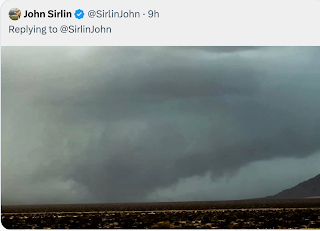Proposed Modifications to the Tornado Warning System
I presented my paper with proposed modifications to the American Meteorological Society's storm warning and communications meeting this afternoon. I proposed four significant changes:
#1) For warnings for the general public, we should aim to provide everyone with 15 minutes of warning for a tornado. Increasingly, research indicates that too much lead time has serious downsides: People start trying to protect possessions, people try to drive away at the last minute, etc.
#2) All warnings should have an explicit "all clear." This was impossible in the era when bandwidth was scarce. Now, it can be accomplished relatively easily. People want the reassurance they can come out of the basement, safe room, etc.
#3) In before the internet, watches had to be large because teletypes were slow and communications outlets limited. An example of the "too large" watch is below. Some watches run nine hours or more. This is too long.
I suggest an area of research known as "warn on forecast" be converted in a new watch strategy: Smaller watches (example below) that are in effect for one to three hours at any given location.
With this type of system, people at extreme risk (i.e., those in wheelchairs, untied mobile homes, etc.) would have the option of driving to a place of safety. This is adequate time to protect property (i.e., take valuables into the basement, drive home from after school activities, etc.).
#1) For warnings for the general public, we should aim to provide everyone with 15 minutes of warning for a tornado. Increasingly, research indicates that too much lead time has serious downsides: People start trying to protect possessions, people try to drive away at the last minute, etc.
#2) All warnings should have an explicit "all clear." This was impossible in the era when bandwidth was scarce. Now, it can be accomplished relatively easily. People want the reassurance they can come out of the basement, safe room, etc.
#3) In before the internet, watches had to be large because teletypes were slow and communications outlets limited. An example of the "too large" watch is below. Some watches run nine hours or more. This is too long.
I suggest an area of research known as "warn on forecast" be converted in a new watch strategy: Smaller watches (example below) that are in effect for one to three hours at any given location.
With this type of system, people at extreme risk (i.e., those in wheelchairs, untied mobile homes, etc.) would have the option of driving to a place of safety. This is adequate time to protect property (i.e., take valuables into the basement, drive home from after school activities, etc.).
#4) I also suggest the Storm Prediction Center issue a new Day 2 Outlook daily at 3:30pm Central time. This could incorporate the European model which would likely increase the accuracy. This would be incorporated into drive-time radio and evening television newscasts and would serve as an important "heads up" for people in the affected area. The latest Day 2 Outlook is issued at 12:30pm CDT which is too late for the noon news in the key Central and Eastern time zones of tornado alley.
Finally, I presented a video that demonstrates people do not need to be "frightened into shelter." The current NWS Impact-Based Warnings experiment should be discontinued. The video clearly demonstrates that people will do the right things to save their lives if you give them the right information in a timely fashion.







Comments
Post a Comment